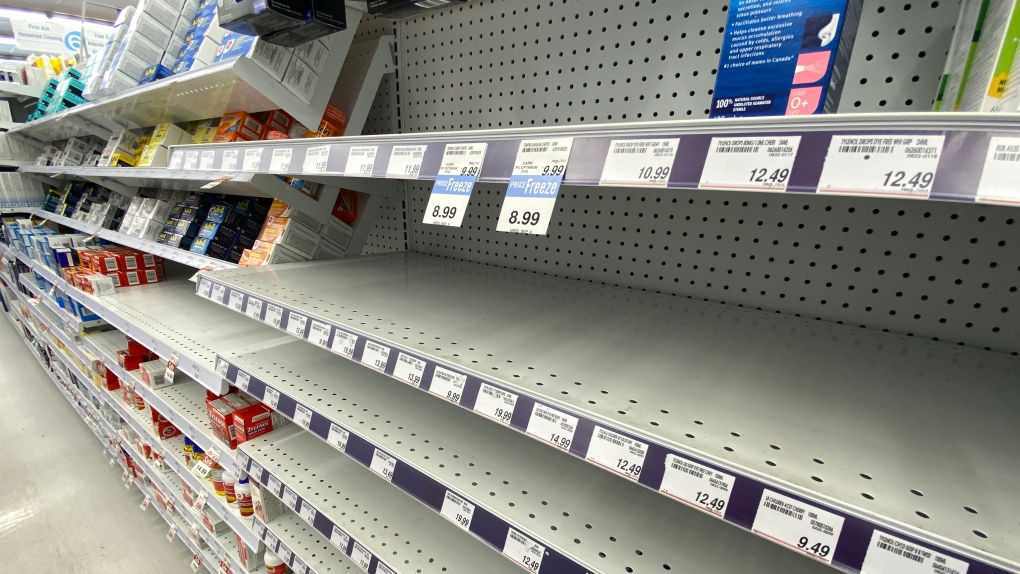Empty shelves in children medicine: who’s to blame?
The last few months have not been easy on Canadian parents and their children, of course. Due to limited stock, access to simple fever and pain medication, such as Tylenol and Advil, has become increasingly frustrating and expensive. Everyone with children already knows the difficulty of dealing with a child’s cold or flu, especially during the winter months. This season, the situation was even more aggravated by Covid-19 and RSV (Respiratory syncytial virus). To complicate the scenario, pediatric emergency rooms were dealing with an unprecedented number of patients. So, not only were people struggling to find over-the-counter medication to help their children, but they were also discouraged from bringing them to the overcrowded hospitals, unless absolutely necessary.
The question everybody was asking was: why is this happening? Why is there a shortage in pediatric medicine? Theories have been emerging, and the cause may vary according to your beliefs or understandings. Some people tried to blame international relations and trade agreements, often with China, who’s an important producer of some key Active-Pharmaceutical-Ingredients (APIs) used to manufacture drugs in the US.
But according to the Canadian experts we interviewed this week for Milénio Stadium, the unusual shortage in pediatric medicine, is more related to demand increases, rather than supply shortages. Supply chain infrastructure in many industries, from computers to food, to cars, has been affected like many other sectors for the past few years because of the global pandemic. But most of all, experts blame an increase in demand itself for the unprecedented empty shelves of children’s Tylenol and Advil.
Angelique Berg, President & CEO of the Canadian Association for Pharmacy Distribution Management (CAPDM), pointed out that in 2022, earlier than usual heightened demand in April didn’t allow suppliers enough time to build inventory. Even more so, the high level of demand has remained high for most of the year, creating a huge catch-up challenge for manufacturers. Furthermore, Anthony Fuchs, the Vice- President of Communications of Food, Health & Consumer Products of Canada agreed this was not an issue of reliance on imported products but of unprecedented demand. They both also talked about the lessons learned with these shortages, like highlighting the need for cooperation between governments, industry, and medical officials at both a national and global level, and to ensure the ability to quickly respond to emerging threats. This, and reinforce that Canada is not alone in this situation with global manufacturers working well over historical production capacity to meet demand.
The good news is that some kind of normalcy is coming back, after the government announced last week that more than a million doses were inbound to Canada from abroad. This is a relief for those families who have been dealing with the shortages over the last year. We all hope this is not the new “normalcy” for Canada, nor any other country.

Milénio Stadium: Canada is facing an unprecedent shortage of kid’s fever and pain medication. Who’s to blame?
Anthony Fuchs: Shortages of pediatric analgesics are a worldwide problem. This reflects the fact that medication is not immune to the types of supply chain problems that have impacted other sectors for the past few years. Rather than looking at who is to blame, our focus continues to be on finding solutions behind the scenes that are aimed at addressing the issue – specifically working with manufacturers, Health Canada, pharmacists, retailers etc. Health Canada recently announced that shipments of imported children’s medication would be available for retail purchase soon to help alleviate availability concerns and support the ability of the supply chain to “catch up” to increased demand.
MS: When a country like Canada faces a problem like this, what does that mean? Are we relying too much on imported essential products?
AF: This is not an issue of reliance on imported products. This is an issue of unprecedented demand. Manufacturers had planned for higher-than-normal demand for this year’s cold and flu season, but that demand started to rise back in the spring ahead of expectations. That put pressure on inventories which then experienced a further spike in demand in early fall that was three to four times above expectations, at a time when supply chains were still not recovered from the pandemic and rates were rising globally.
MS: Some experts say this situation highlights long-standing vulnerabilities in Canada’s drug supply. Do you agree?
AF: This situation highlights the need for greater investment in Canada’s domestic manufacturing capacity, supported through the removal of long-standing regulatory barriers that have traditionally limited industry growth. It also serves as a reminder of the importance of global trade in helping to address the unpredictable nature of supply/demand resulting from large scale public health situations.
MS: Canada has restrictions towards some foreign medications. Would easing some policies be a possible solution to this problem, so we could have more brands available, besides Tylenol and Advil, for example?
AF: Canada has an established and respected drug approval process aimed at prioritizing the safety and well-being of all Canadians. Drugs are authorized for sale in Canada once they have successfully gone through the drug review process. This process is the means by which a drug application is reviewed by scientists in the Health Products and Food Branch (HPFB) of Health Canada, and on occasion, outside experts, to assess the safety, efficacy and quality of a drug. While increasing the number of brands available to Canadians could help to lessen the impact of future shortages in theory, that cannot be done at the expense of public safety.
MS: Worldwide there are other countries facing the same problem of certain medications shortage. Can this situation be considered a threat to global health security?
AF: There is no doubt that global pandemics and larger public health emergencies have the capacity to strain existing medication stockpiles and the ability of supply chains to keep up. With consideration to the current shortage of pediatric analgesics, we have seen shortages occur over the past year in France, Ireland, Pakistan, Germany, Malaysia and Japan. While concerning, these shortages highlight the need for cooperation between governments, industry and medical officials at both a national and global level to ensure the ability to quickly respond to emerging threats.

Milénio Stadium: Canada is facing an unprecedent shortage of kid’s fever and pain medication. Who’s to blame?
Angelique Berg: A demand shift is behind the children’s fever and pain medication shortages, and of related products like antibiotics and adult cold and flu medications. Typically, Canadian manufacturing volumes of these products are more than enough to meet demand, which is why Canada has never faced a shortage of them. The demand shifted from the usual fall cold and flu season to April, much earlier than ever before. In spring and summer, cold and flu products normally are in very low demand, largely sitting unsold on pharmacy shelves. Over the spring and summer, manufacturers steadily produce cold and flu medications and ship them to distributors, who hold and build the inventory, in preparation for the cold and flu season shipments to pharmacies. By end September, distributors are fully stocked with product that is built over a six-month period. This year, demand started in April without any time to build inventory, and the demand has stayed high, creating a huge catch-up challenge for manufacturers.
MS: When a country like Canada faces a problem like this, what does that mean? Are we relying too much on imported essential products?
AB: These products are manufactured in Canada in volumes that normally are more than enough to meet demand. This demand shift took the entire country by surprise, requiring some assistance to close the gap between demand and supply, which Health Canada is facilitating. The system will recover.
MS: Some experts say this situation highlights long-standing vulnerabilities in Canada’s drug supply. Do you agree?
AB: The children’s fever and pain medication shortages are highly unusual, and not emblematic of vulnerabilities. Canada’s drug supply chain is safe, secure, and meets the great majority of needs the majority of the time, and we can do better. Building resilience in Canada’s drug supply chain is critical to preventing shortages, and key among those strategies must be the building inventory of critical medicines to meet demand fluctuations.
MS: Canada has restrictions towards some foreign medications. Would easing some policies be a possible solution to this problem, so we could have more brands available, besides Tylenol and Advil, for example?
AB: Canada’s medication supply is tightly regulated for the safety of Canadians. In exceptional circumstances, Health Canada can ease the regulations or speed inspections, like they are doing right now with children’s pain and fever medications.
MS: Worldwide there are other countries facing the same problem of certain medications shortage. Can this situation be considered a threat to global health security?
AB: Canada is not alone in facing the demand shift. Manufacturers are working well over historical production capacity to meet demand, and they will catch up.
Lizandra Ongaratto/MS
.









Redes Sociais - Comentários